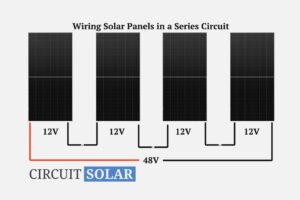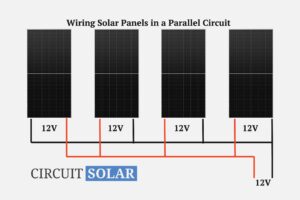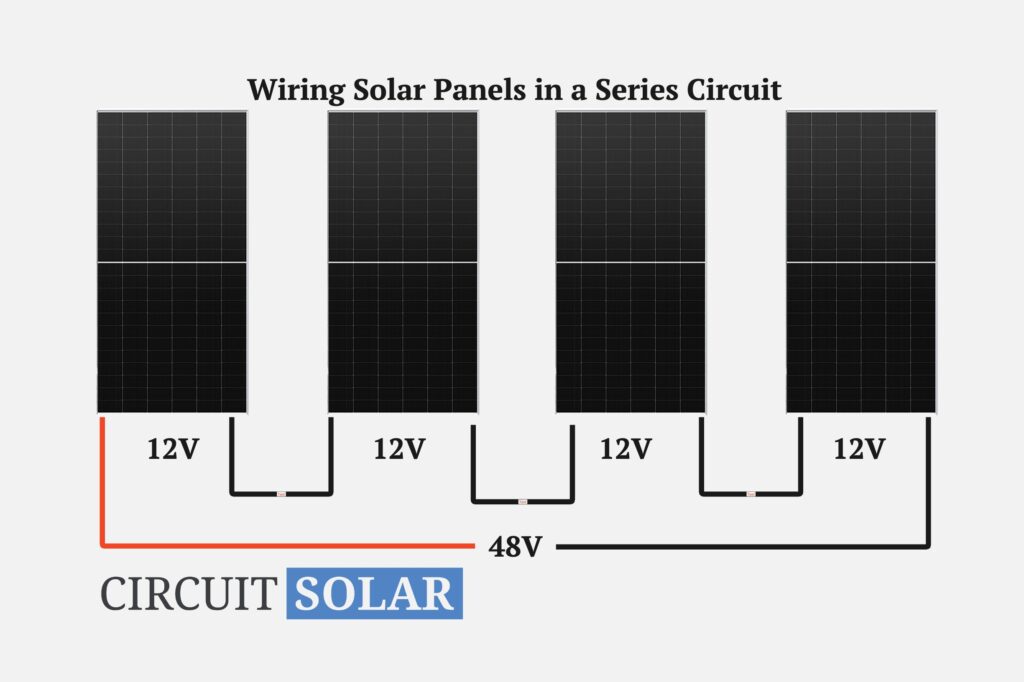Different Ways to Wire Solar Panels: A Comprehensive Guide to Series, Parallel, and Series-Parallel Configurations for Residential, Off-Grid, and Hybrid Systems
Are you wondering how to wire solar panels effectively for maximum efficiency? Whether you’re setting up a residential solar system, an off-grid solar installation, or a hybrid solar setup, understanding solar panel wiring methods is crucial. Proper wiring optimizes energy output, ensures safety, and extends system longevity. In this ultimate guide, we explore series wiring solar panels, parallel wiring solar panels, and series-parallel wiring, including pros, cons, and best applications. At Circuit Solar, we prioritize reliable connections to build robust solar energy systems that deliver clean power seamlessly.
Keywords like “solar panel wiring diagram,” “series vs parallel solar panels,” and “best way to wire solar panels” often lead homeowners here, and we’ll cover it all with practical insights and clear diagrams.
Why Wiring Matters in a Solar Circuit: Ensuring Efficiency and Safety in Your Solar Panel Setup
Imagine your solar power system as an electrical network where solar panels generate DC power, and wiring acts as the pathways directing energy to inverters, batteries, or the grid. Incorrect solar panel wiring can cause significant issues, including:
- Voltage imbalances that hinder inverter performance
- Decreased solar system efficiency due to power losses
- Safety risks like overheating, electrical faults, or fires
- Inefficient battery charging in off-grid solar systems
By selecting the optimal wiring configuration for solar panels, you minimize energy losses, enhance reliability, and align with your specific needs—whether it’s a grid-tied residential solar installation or a battery-backed hybrid system. Let’s dive into the fundamentals to help you choose the right approach.
The Main Ways to Wire Solar Panels: Series, Parallel, and Series-Parallel Explained
There are three primary methods to wire solar panels: series, parallel, and a hybrid series-parallel combination. Each affects voltage, current, and performance differently, making them suitable for various solar installations. Below, we break them down with solar wiring diagrams for clarity.
1. Series Wiring for Solar Panels (Higher Voltage, Lower Current)

In series wiring solar panels, panels are linked in a chain: the positive (+) terminal of one panel connects to the negative (-) terminal of the next, creating a single pathway for current.
- Effect on Output: Voltages add up (e.g., three 12V panels yield 36V), while current (amps) remains constant.
- Best For: Grid-tied residential solar systems that pair with high-voltage string inverters, reducing cable costs and losses.
- Pros:
- Minimizes power loss over long distances due to lower current.
- Ideal for high-voltage solar inverters in modern setups.
- Cons:
- Shading on one panel affects the entire string’s output (known as the “Christmas light effect”).
2. Parallel Wiring for Solar Panels (Lower Voltage, Higher Current)

In parallel wiring solar panels, all positive (+) terminals are joined together, and all negative (-) terminals are connected as a group, allowing multiple current paths.
- Effect on Output: Currents add up (e.g., three 5A panels yield 15A), while voltage remains the same as a single panel.
- Best For: Off-grid solar systems and battery-based setups using low-voltage charge controllers (e.g., 12V or 24V systems).
- Pros:
- Tolerant to shading—one underperforming panel doesn’t impact others.
- Safer for smaller, low-voltage DIY solar installations.
- Cons:
- Higher current demands thicker, more expensive cables to avoid overheating.
- Less efficient for long cable runs due to increased losses.
3. Series-Parallel Wiring for Solar Panels (Balanced Voltage and Current)
For scalable systems, series-parallel wiring groups panels into series strings first, then connects those strings in parallel. This hybrid method offers customization.
- Effect on Output: Boosts both voltage (from series) and current (from parallel) to match system needs.
- Best For: Large residential solar systems, commercial solar installations, and hybrid solar systems with batteries and grid tie-in.
- Pros:
- Provides flexibility for optimal inverter matching and shading tolerance.
- Balances efficiency, scalability, and performance in mixed environments.
- Cons:
- More intricate planning and wiring, increasing installation complexity.
Wiring Solar Panels for Different Installations: Tailored Advice for Residential, Off-Grid, and Hybrid Systems
Choosing the right solar wiring method depends on your setup. Here’s how to apply these configurations:
Residential Solar Systems: Optimizing for Grid-Tied Efficiency
Residential solar panel wiring typically favors series or series-parallel to achieve high voltages for grid-tied inverters. This suits rooftop layouts, minimizing shading issues with optimizers if needed. Search terms like “residential solar wiring diagram” often highlight these for easy scalability.
Off-Grid Solar Systems: Prioritizing Reliability and Battery Charging
For off-grid solar wiring, parallel configurations shine, maintaining low voltages compatible with 12V/24V/48V batteries and MPPT controllers. This ensures consistent charging even in variable sunlight, ideal for remote cabins or RVs.
Hybrid Solar Systems: Flexibility for Grid and Battery Integration
Hybrid solar panel wiring often uses series-parallel to blend grid connectivity with battery storage. This allows seamless energy shifting, maximizing self-consumption and backup power during outages.
Key Considerations When Wiring Solar Panels: Tips for Safe and Efficient Setups
To avoid common pitfalls in solar panel circuit wiring, keep these factors in mind:
- Match Inverter and Controller Specifications – Design your solar array wiring to fit voltage/current limits of your MPPT charge controller or inverter.
- Handle Shading Effectively – Use parallel wiring or add microinverters/power optimizers in shaded areas to prevent output drops.
- Choose the Right Wire Size – Parallel setups need thicker gauges (e.g., AWG 10+) to handle higher amps without voltage drop.
- Prioritize Safety – Incorporate fuses, circuit breakers, grounding, and disconnect switches to protect against faults in your solar electrical wiring.
By following these guidelines, you’ll build a durable solar power wiring system that performs optimally. If you’re planning a project, consult a professional installer like Circuit Solar for customized advice.
Ready to wire your solar panels? Share your system details in the comments for tailored tips! For more on solar installation guides, check our related articles on inverters and battery sizing.

